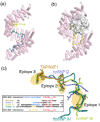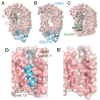Recognition of nuclear targeting signals by Karyopherin-β proteins
- PMID: 20951026
- PMCID: PMC2994982
- DOI: 10.1016/j.sbi.2010.09.008
Recognition of nuclear targeting signals by Karyopherin-β proteins
Abstract
The Karyopherin-β family of nuclear transport factors mediates the majority of nucleocytoplasmic transport. Although each of the 19 Karyopherin-βs transports unique sets of cargos, only three classes of nuclear localization and export signals, or NLSs and NESs, have been characterized. The short basic classical-NLS was first discovered in the 1980s and their karyopherin-bound structures were first reported more than 10 years ago. More recently, structural and biophysical studies of Karyopherin-β2-cargo complexes led to definition of the complex and diverse PY-NLS. Structural knowledge of the leucine-rich NES is finally available more than 10 years after the discovery of its recognition by the exportin CRM1. We review recent findings relating to how these three classes of nuclear targeting signals are recognized by their Karyopherin-β nuclear transport factors.
Copyright © 2010 Elsevier Ltd. All rights reserved.
Figures



Similar articles
-
Nuclear localization signals for four distinct karyopherin-β nuclear import systems.Biochem J. 2015 Jun 15;468(3):353-62. doi: 10.1042/BJ20150368. Biochem J. 2015. PMID: 26173234 Review.
-
Rules for nuclear localization sequence recognition by karyopherin beta 2.Cell. 2006 Aug 11;126(3):543-58. doi: 10.1016/j.cell.2006.05.049. Cell. 2006. PMID: 16901787 Free PMC article.
-
Crystal structure of human Karyopherin β2 bound to the PY-NLS of Saccharomyces cerevisiae Nab2.J Struct Funct Genomics. 2013 Jun;14(2):31-5. doi: 10.1007/s10969-013-9150-1. Epub 2013 Mar 28. J Struct Funct Genomics. 2013. PMID: 23535894 Free PMC article.
-
A PY-NLS nuclear targeting signal is required for nuclear localization and function of the Saccharomyces cerevisiae mRNA-binding protein Hrp1.J Biol Chem. 2008 May 9;283(19):12926-34. doi: 10.1074/jbc.M800898200. Epub 2008 Mar 14. J Biol Chem. 2008. PMID: 18343812 Free PMC article.
-
Nuclear import by karyopherin-βs: recognition and inhibition.Biochim Biophys Acta. 2011 Sep;1813(9):1593-606. doi: 10.1016/j.bbamcr.2010.10.014. Epub 2010 Oct 26. Biochim Biophys Acta. 2011. PMID: 21029754 Free PMC article. Review.
Cited by
-
Identification of the Karyopherin Superfamily in Maize and Its Functional Cues in Plant Development.Int J Mol Sci. 2022 Nov 15;23(22):14103. doi: 10.3390/ijms232214103. Int J Mol Sci. 2022. PMID: 36430578 Free PMC article. Review.
-
Multiple types of nuclear localization signals in Entamoeba histolytica.Biochem Biophys Rep. 2024 Jul 4;39:101770. doi: 10.1016/j.bbrep.2024.101770. eCollection 2024 Sep. Biochem Biophys Rep. 2024. PMID: 39055170 Free PMC article.
-
Nuclear export inhibitors avert progression in preclinical models of inflammatory demyelination.Nat Neurosci. 2015 Apr;18(4):511-20. doi: 10.1038/nn.3953. Epub 2015 Feb 23. Nat Neurosci. 2015. PMID: 25706475 Free PMC article.
-
Nuclear Exportin 1 (XPO1) Binds to the Nuclear Localization/Export Signal of the Turnip Mosaic Virus NIb to Promote Viral Infection.Front Microbiol. 2022 Jan 4;12:780724. doi: 10.3389/fmicb.2021.780724. eCollection 2021. Front Microbiol. 2022. PMID: 35058899 Free PMC article.
-
Functional analysis of nuclear localization signals in VP1-2 homologues from all herpesvirus subfamilies.J Virol. 2014 May;88(10):5391-405. doi: 10.1128/JVI.03797-13. Epub 2014 Feb 26. J Virol. 2014. PMID: 24574406 Free PMC article.
References
Publication types
MeSH terms
Substances
Grants and funding
LinkOut - more resources
Full Text Sources

